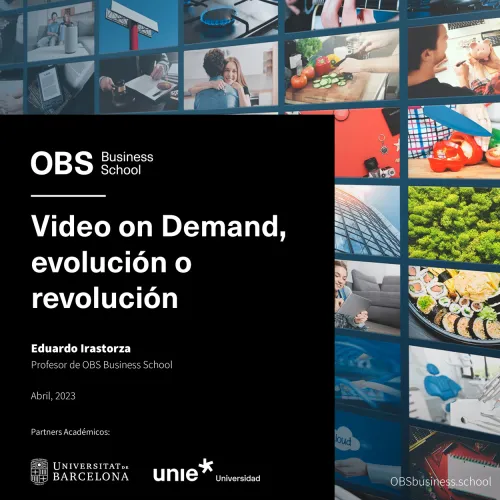
OBS Report: Video on Demand, evolution or revolution?
In only five years the VOD industry will surpass cinema and television
- The Video On Demand industry grows 15,6% annually since 2017.
- The biggest platforms are in the United States, with Netflix leading the way, but in five years' time China will be the undisputed world leader in terms of number of users.
- Platforms will become intermediaries for a huge number of content producers and we will be trained for this from childhood.
- 62% of users consume subscription VOD and are mainly looking for dramas, action movies, comedies and crime and thriller series.
OBS Business School has published the report Video on demand, evolution or revolution, directed by Professor Eduardo Irastorza. In it, we see that the video on demand (VOD) sector has been growing at a rate of 15.6% per year since 2017, which explains why it is so difficult to define its limits and establish clear boundaries with other communication tools.
This rapid evolution is a clear symptom of the comprehensive transformation our way of life has undergone in recent years. Today, the level of VOD penetration in our lives and consumption habits is clearly higher in the most developed countries in the West, with the United States leading the way, followed by Canada, the United Kingdom, Germany and Norway. However, the trend is moving eastwards, where the two most populous countries on earth, China and India, with over 1.5 billion inhabitants each, still have a lot of room for growth.
Estimates for the future could not be more promising. Globalisation is contributing to its expansion and the use of mobile devices is rapidly transforming consumption habits. In fact, modern Smart TVs are already competing with mobiles in the viewing of series, documentaries and films, which are the favourite content. Eduardo Irastorza states that "Television has become the device on which we rarely watch television".
How does the profitability of the sector work?
The sector is profitable thanks to the different existing payment methods and advertising, but a constantly changing reality will force the reinvention of these formulas and the development of new options, such as sponsorship or product placement, the report predicts.
Subscription (SVOD) accounts for more than 85% of the nearly $111 billion estimated turnover for 2023 in this booming sector. Behind it, a long way behind, is PVOD or Push Video On Demand (the deferred viewing of recorded content) with nearly 13 billion. It is expected that, in the near future, as with YouTube, it will be common to pay a premium to avoid being subjected to the unexpected and frequent bombardment of advertising. Thus, one of the strengths of VOD over conventional television, which led us to prefer this model, will have been largely lost.
The most relevant platforms in each country
The United States is the largest producer of content and doubles the figures of Europe and China, its main competitors. The biggest platforms are there because it has a powerful ally: its culture, closely associated with leisure, which since the middle of the last century has successfully exported a lifestyle that, in many respects, people all over the world feel is theirs. However, its growth is three points lower than in Europe and two points lower than in China. The trend is therefore towards greater balance, especially as the huge and populous Asian market increases its income and consolidates its own production. For its part, the United Kingdom generates more content than any other European country.
Undoubtedly, the big VOD player is Netflix, followed by Amazon Prime Video, Disney and Apple, all located in the United States. As in other sectors, the Pareto principle applies in this sector: approximately 20% of the participants account for most of the turnover, while the rest settle for shares of less than two figures. These platforms are often the same in all countries, with the relevant exception of China, which has its own exclusive players and is decidedly closed to outside influences.
One might think that this is an oligopoly controlled by Netflix and Amazon Prime Video, although each country usually has an honourable exception, such as Hulu in the United States, Now TV in the United Kingdom, Tinvision in Italy or Movistar in Spain. Other players such as Disney and HBO are fighting to increase their presence with a global strategy.
Consumption and content
The proportion of VOD platform users who are subscribers is no less than 62% among those who spend more than 6 hours a week on it. A business worth millions of hours and billions of dollars. Dramas are the most requested content, followed by action movies, comedies and crime and thriller series, while documentaries continue to be popular.
Each of the existing platforms has become strong in one form of content, with Amazon Prime video having what financiers would describe as a ‘very well-balanced’ offering, with an increasing emphasis on documentaries. Netflix dominates the production of its own content, especially series (2,185 which have allowed it to achieve a solid leadership in economic terms). Hulu offers Americans the highest volume of comedies and documentaries, and Disney, which is betting heavily on subscriptions for film and animated series, has the unbeatable characters and adventures of Pixar, Marvel and Star Wars.
It is the Boomers and the very young Generation Z who are most sensitive to price and the ease of cancelling subscriptions when choosing a platform. And the youngest are the most open to discovering new content.
What does the future hold for VOD?
The future outlook for the sector is clearly optimistic, with only the video games sector showing as much momentum as the content platforms and as promising a future as VOD. Users are expected to spend more money on VOD and the preferred mode will continue to be subscription (1.667 billion subscriptions are expected, of which almost 1 billion will be new subscriptions). In five years, VOD will overtake conventional television in terms of consumption worldwide and will account for the largest share of audiovisual production budgets, even more than cinema.
The distances between the different European countries will also have shortened considerably. Globally, China will be the undisputed world leader in terms of number of users thanks to its huge population, but it remains to be seen whether they will be served only by its own production or whether it will open up to other markets with the risk of the ideological impact that the Chinese authorities fear. The OBS report indicates that it is very likely that in order to create their own content they will be ‘inspired’ by foreign productions, or else participate in the production of emerging countries, such as India, which provide diversity and adhere to common criteria.
Western culture will cease to be the benchmark for content, which will also have to be responsive in order to adapt to current and new digital devices. Likewise, platforms will become intermediaries for an enormous number of content producers, which we will all be able to become, and for this we will be trained academically from childhood. For their part, the big names in acting will be obliged to go through VOD series.
Written by
Carmen García-Trevijano
OBS Business School Press Office
